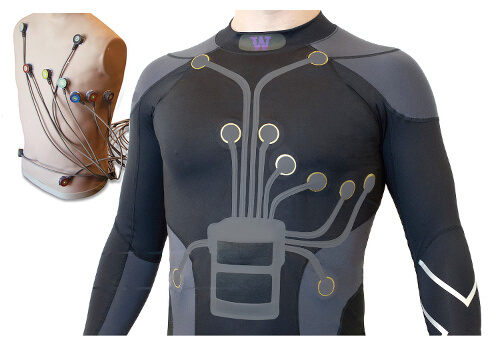Smart textiles in healthcare
The Smart fabrics also famous as electronic textiles and smart textiles are digital enhanced fabrics that uses technology of light and battery to operate. These fabrics have technology to sense the environmental condition. The smart fabrics work through the signals that are received from the central control unit. The electrical processor embedded in the fabric analysis and evaluates the signals. The entire functioning of the smart fabrics work with the help of nanotechnology.
Some of the generic applications of smart textiles are healthcare (telemedicine and use of biomedical clothing), Life belt (transabdominal wearable device), Life Jacket (constantly monitors and read the heart rate measurements and blood pressure), Military defence (monitoring toxic gases and prevents injuries), sportswear (monitoring athlete performance) , fashion and entertainment (club wear garments that reacts to light and environment), and the smart bra (measures hear rates through sensors).
The smart textiles in the health industry are helpful for monitoring ECG, heart rate, EMG and EEG.
It is therefore used for continuously monitoring the patient’s condition and for receiving communication and positioning. Using the smart wearable garments, the problem of mobility or infrequent clinical visits can be solved out.
The smart fabric market is gaining popularity amongst all the sectors, especially the health sector. The different startup companies serving the world with the smart textiles in health segment are Pireta, Stitch Institute, Clothing+, Hexoskin, etc. The market segment of the smart fabrics in the health segment is quite huge and is expected to reach 1000 Million USD by the end of 2024.

Image courtesy of Grand View Research USA
| Recommended for you | |
| Interesting applications of wearables in sports | |
| Top 5 wearable devices for monitoring sleep | |
| Making sense of digital health wearables market: Beyond the hype |
Top startups developing smart textiles for healthcare
After detailed R&D and analysis on nanotechnology and it’s integration with the non-woven fabric, numerous companies around the world have established themselves as the manufacturers of the smart textiles for serving medical and athletes needs such as the Clothing Plus, Camria, Hexoskin, Pireta, Stitch, 3Tecks etc.
These medical smart textiles serve the nursing homes, hospitals and other medical institutions with their smart fabric products such as smart medical gowns, smart pediatric wear, medical clothes, etc.
These smart fabrics are the most useful sources for the hospitals and nursing homes to get accurate patient data through the senses embedded in them. The top startups developing smart textiles for healthcare are:
1. Clothing+
For both the sports and medical era, the Clothing+ is developing smart fabrics and wearables to track the continuous condition of the patient through the nanotechnology.
The company produces large number of medical applications such as heart,brain and lungs monitoring solutions along with smart blankets. Their fabrics are comfortable to wear and accurate for analyzing the data and information.
2. Camira Fabrics
Using the nanotechnology, the Camira fabrics company provides smart fabrics to the different hospitals, nursing homes and assisted living. It helps the healthcare industry to record the health status of a person through the use of smart fabrics.
3. Hexoskin
Hexoskin smart fabrics assist the healthcare professionals in different therapeutic areas such as the Cardiology, Mental disorders, Neurology, Pediatrics and Respiratory.
Their fabrics are embedded with cardiac, movement and breathing sensors for tracking the patient’s data as per the health segment. It uses the smart nanotechnology for the same.
4. Pireta
For continuous physiological monitoring and emergency care the Pireta develops smart sensor garments using the nanotechnology for assisting the hospitals and nursing homes. Their smart fabrics are comfortable and durable. Moreover, their smart fabrics are customized as per the selection of garments.
5. Stitch
Stitch helps to give a more streamlined healthcare system by developing yarns and textiles with the best of nano fibers and nano composites. It uses the best of nanotechnology for manufacturing the smart fabrics that helps the nursing homes and hospitals to have an easy monitoring of patients.
It helps to solve the problems of infrequent clinic visits by directly supervising the patient’s health through smart textiles.
6. 3Tecks
The company has been producing non woven fibers using the best of nanotechnology for assisting the medical care since years. They have vast numbers of products to be used in the hospitals and nursing homes.
The smart textile companies need a good budget to operate and hence, they welcome many investors on board for collaborating their idea of introducing smart fabric wear in the health department. The market is huge and is expanding over time for helping the different hospitals and medical institutions.
The explosion in smart wearables devices market
The smart nanotechnology is behind the success of the smart fabrics, which are famous for assisting the hospitals and nursing centers for across the globe. Using the skin as a communication or interface, this technology has brought great solutions for the big medical industries.
The healthcare sector has benefited a lot with these smart hospital wear for tracking and monitoring the patient’s data by removing the paperwork. The smart pediatric wear for the premature babies have proved really useful for continuously monitoring the ECG or heart rate measurements in the ICU.
Even though there is an increase demand for the smart textiles in the healthcare industry, the market growth will be sluggish due to the expensive rates and high budget.
It is expected that the new research and development might help the technology to develop in a cost effective way for helping the health industries worldwide. Though the smart fabrics are quite useful and potential for the health sector, it is still difficult to bring the smart textile industry directly to the masses.
The products of smart textiles are little hyped and it is still a long road ahead for the manufacturers of the smart textiles to get right through the masses. If we look from the budget point of view. There are many countries who are not yet developed and hence, they need some really cost effective products for monitoring the patients in their healthcare industry or segment.
The smart textile fabrics are costly because of the cost incurred after the research and development of the technology and resources. If the costs are cut down, it will be easy to introduce the smart fabrics to the masses at large.
Image credit: www.medgadget.com

















